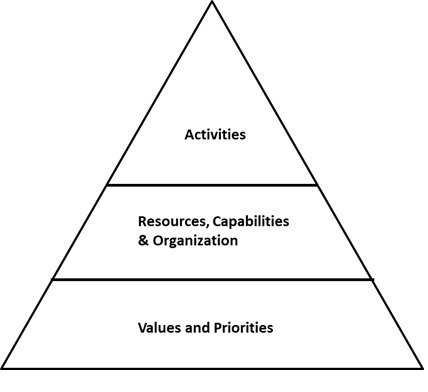
 Data Structure
Data Structure Networking
Networking RDBMS
RDBMS Operating System
Operating System Java
Java MS Excel
MS Excel iOS
iOS HTML
HTML CSS
CSS Android
Android Python
Python C Programming
C Programming C++
C++ C#
C# MongoDB
MongoDB MySQL
MySQL Javascript
Javascript PHP
PHP
- Selected Reading
- UPSC IAS Exams Notes
- Developer's Best Practices
- Questions and Answers
- Effective Resume Writing
- HR Interview Questions
- Computer Glossary
- Who is Who
What is Competitive Advantage Pyramid?
Introduction
Competition advantage in simple terms refers to all the factors that allow a company to perform better than its competitors. It helps the business to produce more quality goods and services with reduced cost generating higher sales and profit. Anything that helps a company to attain an edge over its competitors and attract more customers to spread its market space is termed as competitive advantage. Primarily, it has three factors that leverage advantage over others.
First is the cost advantage, where a business produces or provides a service at a lower cost when compared to its competitors.
Next is the offer advantage, where a specialty or feature is added to the product or service based on customer demands.
The other is offer advantage where the business serves a particular market much better than any of its competitors, almost enjoying monopoly.
Outperforming in at least one of these three factors and remaining competitive in the other two puts a business in a strong position when compared to its competitors. However, if the business achieves only average performance in all three categories, it is unlikely to enjoy a position that makes it stand out in the marketplace. This will eventually cause it to underperform and result in failure. In today's data driven world of advanced technology and digital aided decision making, the competitive advantage scenarios keep changing rapidly. The basic structural pyramid of competitive advantage is discussed in this tutorial that could be adjusted case-to-case to the predicted competition.
Competitive Advantage Pyramid
Based on the factors leveraging advantage to the company, the following questions frame the competitive advantage pyramid. The answers to each of these questions will differ and be unique to each sector and organization based on the products or services they have to offer.
Based on the nature of questions the pyramid is divided into three sections.
The first section or "Activities" contain the following questions:
What is the company good at?
What activities create value for the customer?
The second section deals with the "business resources, capabilities and organization".
What resources and capabilities drive those activities?
How rare are they?
Is it difficult to imitate or copy by the competitors?
In what ways is the organization designed to capture the value created?
The third part of the pyramid focuses on the "values and priorities" of the company.
What priorities and values support the resources and capabilities?
How committed is the organization to these priorities and values?

Competitive advantage of one company cannot be easily replicated and is exclusive to that particular organization or business. This refers to the internal business that is distinct and unique which sets the business apart from its competitors. Each of the section of the pyramid thus gives unique framework for each companies based on its operations.
Activities
The first section analyzes the focus and business activities of the company. It prioritises those activities of the business that give optimum success. This area focuses on the cost factor created for the customers. Some consumers may prefer goods that are cheaper any two perfect substitutes offered. However, for products that may be perfectly substituted including branded items, higher margins for the lowest-cost producers can eventually bring superior returns.
Generally, the major activities that generate higher profits in a business include inbound logistics, operations, outbound logistics, marketing and sales, and services.
Resources, Capabilities and Organization
The second tier of the pyramid refers to the resources, capabilities and organization. A resource-based perspective highlight that a firm uses its resources and capabilities to create a competitive advantage that finally paves way to superior value creation. As per the resource-based perspective an organization should have excellent resources and capabilities than their competitors in order to develop competitive advantage. If the company does not enjoy this excellence of resources and capability any competitor could easily imitate the services or could replicate the products resulting in destroying the competitive advantage attained.
Sustaining competitive advantage transpires when the company succeeds in doing things its competitors cannot easily replicate or imitate. This could include reinforcing company brand, elevating boundaries to new competitors either through regulations and shielding through the defence of intellectual property. These include those resources and business-specific assets that competitors cannot easily acquire. Examples include patents and trademarks, proprietary know-how, permanent customer base, reputation of the firm and brand equity.
Capabilities, in this context, relates to the firm's ability to utilize its resources effectively. For instance, the ability to bring a finished product to market faster than its competitors is called capability. Such capabilities are automatically driven in the routine business activities of the organization and are not specifically charted as procedures or process flows and thus are difficult for competitors to replicate. The resources and capabilities of a company together form its unique competencies. This expertise empowers innovation, efficiency, quality, and customer responsiveness. All these business specific proficiency could be leveraged to create a cost advantage or a differentiation advantage.
Cost Advantage and Differentiation Advantage
Competitive advantage is developed by an organization using resources and capabilities to achieve either a lower cost structure or a differentiated product. This is how a business grabs its position in the concerned industry or sector through its choice of low cost or differentiation. It is rather a decision that makes the central component of the competitive strategy of any company. Yet another significant decision is on the market segment to be targeted, whether it should be broad or a narrow market segment. Michael E. Porter, one of the world's leading authorities on competitive strategy and international competitiveness formed a matrix using cost advantage, differentiation advantage, and a broad or narrow focus to identify a set of generic strategies that the firm can pursue to create and sustain a competitive advantage.
Values and Priorities
The third section of the competitive advantage pyramid deals with the priorities and values that support the resources and capabilities of an organization. It also examines the level of commitment the organization exercises to keep up with these priorities and values. Accordingly, the business creates value by performing a series of activities that Porter identified as the value chain.
Apart from value-creating activities within the business, the firm operates in a value system of vertical activities including those of upstream suppliers and downstream channel members. In this scenario, the firm must perform one or more value creating activities that creates more overall value than its competitors to achieve a competitive advantage. Superior value is often created through reducing costs or providing superior benefits to the consumer.
Conclusion
Competitive advantage makes an entity's products or services more desirable to customers than that of any other companies in the market segment. It sets a business stand out high from its competitors. It is very much essential for a business to succeed, either by ensuring higher margins, by attracting more customers, or achieving greater brand loyalty among existing customers.
As the pyramid gives its distinctiveness from business to business, higher margins, a better growth profile, and lower customer churn also tend be appealing both to investors and creditors. This helps capital more readily available for firms that maintain a strong competitive advantage among their competitors.

